- Early stages of infection
- Later infection; just pulled
- Close up view of basal plate
Stem and Bulb Nematode is a very small parasitic nematode that is possibly the most damaging pest for commercial garlic growers in America. You can barely see them with the naked eye, but the damage is very apparent. They burrow into the neck or bulb of the garlic and consume the bulb, allowing rot to also set in.
Physical Description
D. dipsaci is a very small, worm-like organism. They look like tiny little cellophane noodles, slithering in and out of the bulb, roots, and neck of the garlic. It is endoparasitic, meaning that it lives and feeds within the tissue of the roots, bulb, and stem. This means it is crucial to dig up the surrounding roots when removing and treating.
Species & Taxonomy
- Kingdom:
- Phylum: Nematoda
- Class: Tylenchoidea
- Order:
- Family:
- Genus Species: Ditylenchus dipsaci
Lifecycle
There are 6 stages for plant-feeding nematodes that take 19-28 days to get to the adult stage:
- egg (can survive dry, extreme conditions then hatch when moisture is present)
- 4 immature stages, each of which is accompanied with molting. The fourth jouvenile stage can go into a restive state, in the absence of moisture. They can persist for many years in extreme conditions, then become reactivated with moisture.
- adult, which can then lay more eggs.
As many as 6 generations can occur in one year; especially in warmer climates (15-20 degrees C). Their lifespan is 45-75 days. Once it is introduced, it can persist in the soil for many years. One adult female lays 250-500 eggs per season, but they spread or migrate relatively slowly, at a rate of 3 feet per year.
Somehow the eggs or adults are able to persist in the soil for many years, even without suitable hosts. See the section below on Crop Rotation & Fallowing for information on treatment.
Plants Affected
- Garlic
- Onions, perhaps all members of the Onion Family
- chives
- leeks
- all alliums
- Shasta Pea (Pisum sativum)
- Parsley (Petroselinum crispum)
- Celery (Apium graveolens)
- Salsify (Tragopogon porrifolius)
- Hyacinths (possibly a different strain of Bulb & Stem Nematode)
- Daffodils, Narcissus (possibly a different strain of Bulb & Stem Nematode)
- Phlox (possibly a different strain of Bulb & Stem Nematode)
Plants Unaffected
?
Geographical Range
The Bulb & Stem Nematode is found in most temperate regions of the world, including the US, Europe & Mediterranean region, as well as Asia and Africa. It favors cool, moist growing conditions, so it’s not usually found in the tropics, but it can occure wherevere the infested planting stock can be grown.
This nematode is known by several other names, world wide:
- stem nematode
- stem and bulb eelworm
- onion bloat
- nematode des tiges
- stengelalchen
- stockalchen
Signs & Symptoms
Lightly infested garlic plants may show no symptoms, and when they do, it is yellowing & stunted growth – hard to discern from the million other problems with the same symptoms. Unfortunately the problem differentiates itself when it is a full-blown infestation.
Whole Plant
- stunted growth
- dramatic wilting that occurs suddenly (further stages of infestation)
- upon wiggling the plant, while still in the ground, you will find it to be loosely anchored
Leaves
- pale, thickened leaves that may become twisted or roll, or otherwise stunted in shape. But by the time this symptom shows up, there is usually also rot and decay happening
Neck
- at the bottom of the plant, where it goes underground, it will feel swollen and spongy when squeezed
- vertical cracks or splits below ground
Bulb
-
when pulled from the ground, it will look like the basal plate has been totally rotted or chewed away. This is because the basal plate snaps off and stays in the ground, or it really is rotted or chewed away by secondary infections.
Roots
- appear to be gone, although if you dig in the soil, you will find them still there. Dig them up, since the nematodes could be in this root zone.
How to Positively Identify
- If you see some wilting or stunting of your garlic, wiggle the plant gently. If it is very loosely anchored, nematodes are a possiblity, go on to step 2.
- Lightly squeeze the neck of the garlic, just above where it goes under the soil. If it feels spongy or swollen, go to the step 3. If it doesn’t, then nematodes may not be the problem, or the infestation is very light. You can go on to step 3 without damaging the growing garlic.
- Carefully scrape away the soil around the top of the garlic bulb. What we are looking for is whether or not the bulb is rotting and smelly. A healthy garlic bulb will look bright and hard. A rotting bulb will be soft and easily scraped away by the dirt granules that you are scraping away. If it does appear to be rotting, then carefully dig up the plant, making sure to get the whole root zone. If you were to try to pull the plant out, if these nematodes are the problem, you will hear the basal plate rip off the bulb. You can check for this without pulling the plant out of the ground, when you get the whole plant out of the ground, see if the basal plate easily comes off. Then look closely to see if there is any movement. You are looking for tiny, clear or white little worms, working their way through the bulb flesh and the soil just around the rotting garlic bulb. If you have a microscope at your disposal, you will see the little jerks easily.
Treatment
Early detection & complete disposal are the course of action to take.
If you have Stem & Bulb Nematodes, dig up the infected plants, and all of their root zone soil, and dispose or burn. Watch the neighbors closely, maybe even harvest them early and look for any signs of early infestation, since early infestations are often asymptomatic. Most of the nematodes stay in the plant tissues, rather than the soil, but if any are still in the soil, they can remain dormant for long periods of time.
Prevention & Control
- One source (GGG) says that there is no chemical, biological, or cultural controls known to control this nematode. Since this book is written with organic growers in mind, this may only mean to include organically certifiable chemical, biological or cultural controls. Buying clean planting stock is the only sure way to avoid Stem & Bulb Nematodes, although there is some discussion that it may survive on onion seeds.
Methods
- Planting only certified-nematode-free seed stock
- Plant resistant varieties
- California Early White Garlic may be semi-resistant
- Pre-planting Soak will eradicate the bulb & stem nematode from loose cloves, but not whole bulbs:
- Soak cloves for 30 mins in 100 degree F water containing 0.1% surfactant
- then soak another 20 mins in 120 degree F water containing 0.1% surfactant
- Cool cloves by soaking in tap water for 10-20 minutes
- Then either plant them or dry them for 2 hours at 100 degrees F.
- Sanitary Gardening Practices
- Make sure to not spread the garlic wrappers or stems into your garlic patch, and either dispose of them or compost them fully.
- Clean equipment used in the process of planting or harvesting garlic.
- 3-year Crop Rotation
- By not growing a susceptible host for three years, you can break the cycle of the nematode, but it can still persist. Volunteers and susceptible weeds in patches nearby must be removed vigilantly.
- Fallowing
- by not growing anything in the bed nematode numbers can be reduced. Keep in mind that this area has to be kept weed-free as well as crop-free. One year is good, but 5 years is better.(80-90% per year reduction for root-knot nematode)
- It is most effective if the field or bed is kept watered, to encourage the nematode eggs to hatch. When they find no food, that can’t survive to adulthood so they can’t lay more eggs.
- Tilling every 10 days can speed up their demise, but it is bad for soil structure and the beneficials.
- Amending the Soil with Organic Matter
- adding organic matter increases the populations of natural competitors & predators. See Natural Enemies & Biological Controls for more information.
- Soil Solarization
- Moisten the soil, then lay clear plastic tarps over the soil for 4-6 weeks during the hottest part of the summer. Daytime temperatures need to be at least 80 degrees, F. for it to be warm enough.
- effects can be improved by using a second layer of clear plastic, and by incorporating poultry litter prior to solarization; also, brassica cuttings or residue has a fumigation effect (biofumigation), if they are also incorporated before laying the plastic down.
- This temporarily reduces the nematodes in the top 12 inches of soil.
- This method also kills beneficial soil biology, which is competing for resources with the pest nematodes. When done solarizing, make sure to add compost, composted manure, and/or compost tea to bring biological activity back up.
- Moisten the soil, then lay clear plastic tarps over the soil for 4-6 weeks during the hottest part of the summer. Daytime temperatures need to be at least 80 degrees, F. for it to be warm enough.
Natural Enemies & Biological Controls
- Predators and Parasites of Pest Nematodes
- Predators and parasites of nematodes can be used to prevent and compete, but they have not been shown to consistently reduce nematode damage.
- Predators and Parasites of Pest Nematodes include:
- fungi
- bacteria
- beneficial nematodes
- soil-dwelling insects like collembola
- Ways to add Predators & Competitors:
- Compost
- Compost tea
- composted manure, especially chicken manure
- Commercially available beneficial nematode applications?
- Marigolds
- I was unable to find any resources that discuss marigolds in conjuction with Stem & Bulb Nematodes; only pest nematodes, in general, or root-knot nematodes, specifically.
- Only French marigolds (Tagetes patula) and African marigolds (T. erecta) have nematicidal properties, but they only work if done in a continuous cover crop, with weeds kept out. Work them into the soil after 2 months of growth. This can be done with a lawn mower or weed whacker.Let them dry for a few days then turn them under
- What happens with the marigolds and the nematodes is that the marigold attracts the nematodes, but when they attack the roots, the root releases ozone, which kills the nematode.
Trap Crops
Sprays or Dusts
- Chitin
- Chitin is a protein found in the walls of the nematodes. Many fungi that attack nematodes do so by breaking down the chitin, exposing the nematode to infection or dessication. Adding extra chitin to the soil stimulates the fungi population and seems to speed their action against the nematodes. There are products available with chitin in them, but they may not be considered organic due to their urea content, which is a synthetic fertilizer.
- Here are some options:
- crushed crustacean shells (shrimp, crab, etc.)
- EcoPoly 21 (TM) Microshrimp fertilizer is a shrimp-shell-based fertilizer
- Ground Sesame Stalks
- certified organic growers can try a product made from ground sesame stalks, which suppresses many species of harmful nematodes.
- Essential Oils
- Anecdotal evidence shows that essential oils like mint or oregano can be used to control nematodes.

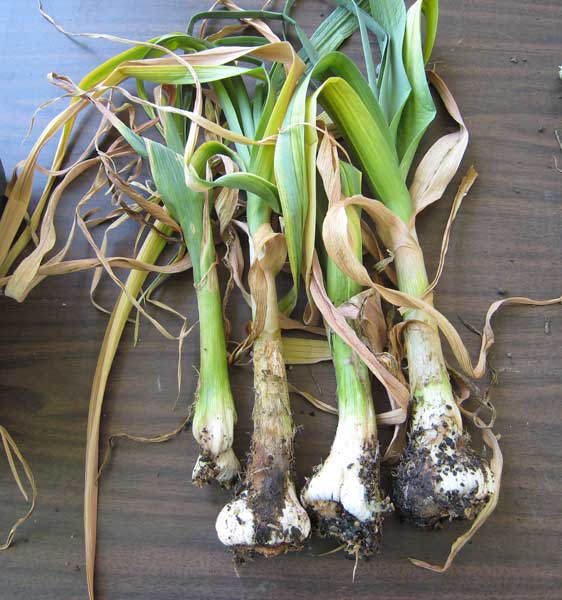
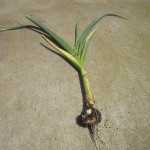
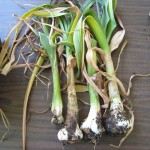
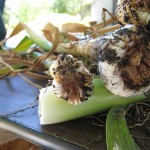
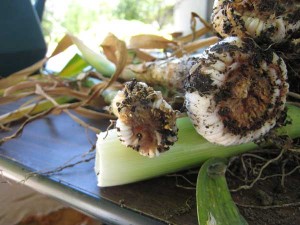

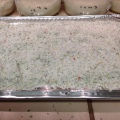
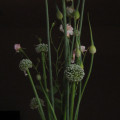
Hi- wow- I have for days and days been reading every scholarly article I can find on the Internet about this bloat nematode and this is the best I have read yet with more and better information than any other source. Congrats. One question: WHat surfectant should we use? Are there any common household items I could use?
Hi Kristen,
Thanks for the glowing praise! I was similarly frustrated when trying to figure out what was going on with my garlic…
For a surfactant, you could try household dish soap, but I’m not sure how to calculate the surfactant content in order to hit the desired (0.1%) concentration. Household dish soap is probably safe, even if you use quite a bit, since they have to dilute the surfactant for household use. If you try this method, you probably don’t want to use an organic or natural brand, since the surfactant they use will have very low-effectiveness at being an actual surfactant.
Let me know how it works for you – I’d be very interested to know.
The method I’ve been using for the past few years is rotation & fallowing, but I’d like this method for the cloves that I’m planting (since I know they haven’t been disease-free, since I have them in my soil!!).
I just harvested my crop last week and I didn’t have any S&B, but they were all on the small side. I thought we had had plenty of rain, but I guess it wasn’t at the right time for bulb formation.
Good luck!!
are garlic infected with Nematodes ok to use to make garlic powder?
Hi Dave!
Yes, the nematodes aren’t harmful to humans – but you’ll want to cut away any of the clove that has been eaten into by them. It will start rotting, if it hasn’t already.